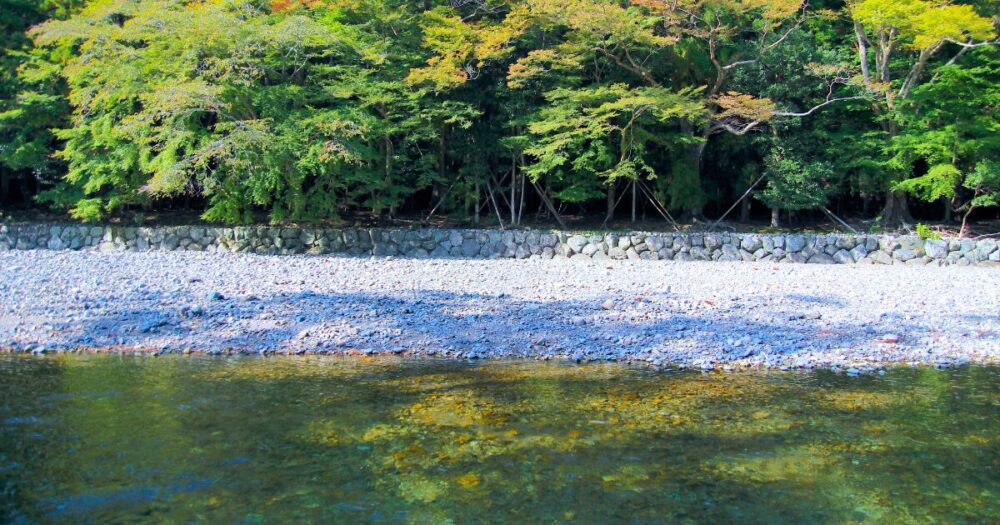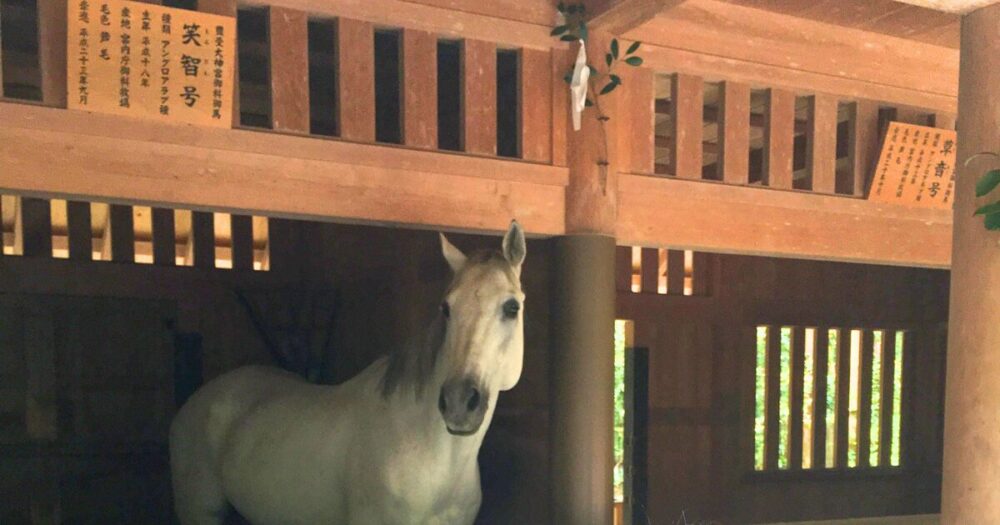Ise Jingu, known for its spiritual significance, has long been cherished as a “power spot.” This sacred place, deeply intertwined with Japanese mythology and legends, offers visitors an otherworldly experience. At Ise Jingu, some people report seeing dragon-shaped clouds or feeling physically rejuvenated, while others may experience headaches due to the strong spiritual energy. This place is filled with spiritual energy. Embark on a journey to cleanse your body and soul. Here, we will introduce some recommended power spots beyond the main and auxiliary shrines.
For those who want to know more about the Ise Grand Shrine, click here.
For those who want to know more about the main and auxiliary shrines, click here.
Power Spots in the Outer Shrine (Geku)
Mitsuishi
On the southern side of the former shrine grounds, there is a stone pile made of three stacked stones. This place is used for the Kawara Oharae purification ritual during the Shikinen Sengu ceremony, where sacred garments and offerings are cleansed. Recently, it has become known as a power spot where people feel warmth when they hold their hands over the stones. While this sentiment is understandable, it’s important to note that the official Ise Jingu website advises against touching or holding hands over this sacred site used for rituals.
Kameishi
Turning off the main path in front of the main hall of Geku, you will find a stone bridge leading to the auxiliary shrines. The flat, large stone here is known as “Kameishi” (Turtle Stone). This stone is believed to have originally blocked the entrance to the “Takakurayama Kofun,” the largest horizontal stone chamber tomb in Mie Prefecture. The tomb is located near the summit of Takakurayama, where the “Takakurayama Kofun” shrine is situated, although it is not accessible for viewing. The stone is named “Kameishi” because the protruding end resembles a turtle’s head.
Kiyomori Camphor Tree
Along the main approach to the Outer Shrine stands a large camphor tree estimated to be around 1000 years old. Though it appears as two trees, it is actually a single trunk. Legend has it that when Taira no Kiyomori visited as an imperial envoy, a branch of the tree touched his hat, prompting him to have the western branch cut. This story gives the tree its name.
Power Spots in the Inner Shrine (Naiku)
Isuzu River
Traditionally, water deities in Japan are often female, and the deity of the Isuzu River is Seoritsuhime no Mikoto, also known as Hashihime. The water flowing in the Isuzu River is considered sacred. Visitors can stand by the river and touch the water to purify their body and soul, wishing for happiness. In the past, before the purification fountain (temizuya) was established, people would cleanse their hands in the Isuzu River.

Uji Bridge
Upon passing through the grand torii gate of the Inner Shrine, visitors cross the Uji Bridge over the Isuzu River. When crossing this bridge, look upstream to see eight pillars erected in the water. These pillars, called “Kiyoke Gui,” are designed to protect the bridge from driftwood during floods by preventing debris from hitting the bridge’s supports. The Uji Bridge is rebuilt every 20 years as part of the Shikinen Sengu ceremony, a tradition that helps preserve the craftsmanship of the artisans involved. The Kiso cypress railings are assembled without a single nail, using traditional joinery techniques, and are lowered into pre-drilled holes in the bridge deck. The deck itself is designed using traditional shipbuilding techniques to prevent rainwater from leaking through. This preservation of ancient techniques highlights the significance of the Sengu tradition.
Miya Horse Stable and Sacred Horse
A white horse, donated by the Imperial family, is kept in the stable for sacred rituals and ceremonies. White horses are considered sacred messengers of the gods. On the 1st, 11th, and 21st of each month at around 8 AM, the sacred horse visits the main shrine, though not in rainy weather or if the horse is unwell. During my visit on the 1st, I was unable to see the horse due to rain, but on a previous visit, I met the sacred horse named “Emitomo,” a memory that stays with me as an animal lover.
The Three Sacred Treasures of Ise Jingu
Ise Jingu enshrines one of Japan’s Three Sacred Treasures, the Yata no Kagami (Eight-Handed Mirror). The Three Sacred Treasures, which also include the Kusanagi no Tsurugi (Grass-Cutting Sword) and the Yasakani no Magatama (Curved Jewel), are deeply tied to Japanese history and tradition. The Yata no Kagami, enshrined in the Inner Shrine, is believed to have been used to lure Amaterasu Omikami out of hiding.
Conclusion
Ise Jingu is a place of profound mysticism and powerful energy. Visiting this sacred site not only brings blessings but also purifies the soul and enhances one’s luck. Experience the sacred atmosphere and boost your fortune by visiting these power spots.



